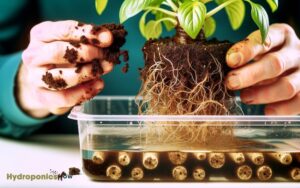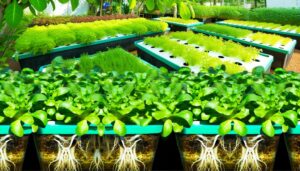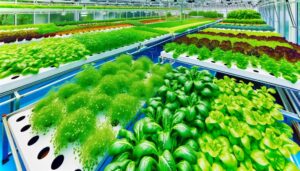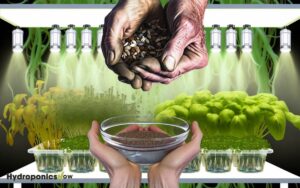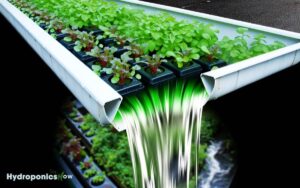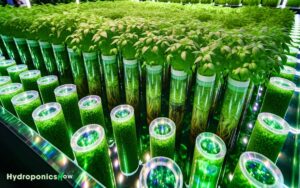Exploring Aquaponics: How Do Fish Help Hydroponic Plants Grow?
Hydroponic plants can indeed be grown with fish through a system known as aquaponics. This integrated, closed-loop approach combines hydroponics and aquaculture to recycle nutrients and conserve water.
Fish produce ammonia, which is converted by bacteria into nutrients for plants, creating a symbiotic environment. Common fish species include tilapia, trout, and catfish, which support plant growth and maintain ecosystem balance.
Aquaponics optimizes resource efficiency, enhances plant growth, and notably reduces water consumption while requiring meticulous water quality management.
For a deeper understanding, explore the specifics of system setup, maintenance, and the technology shaping the future of sustainable agriculture.
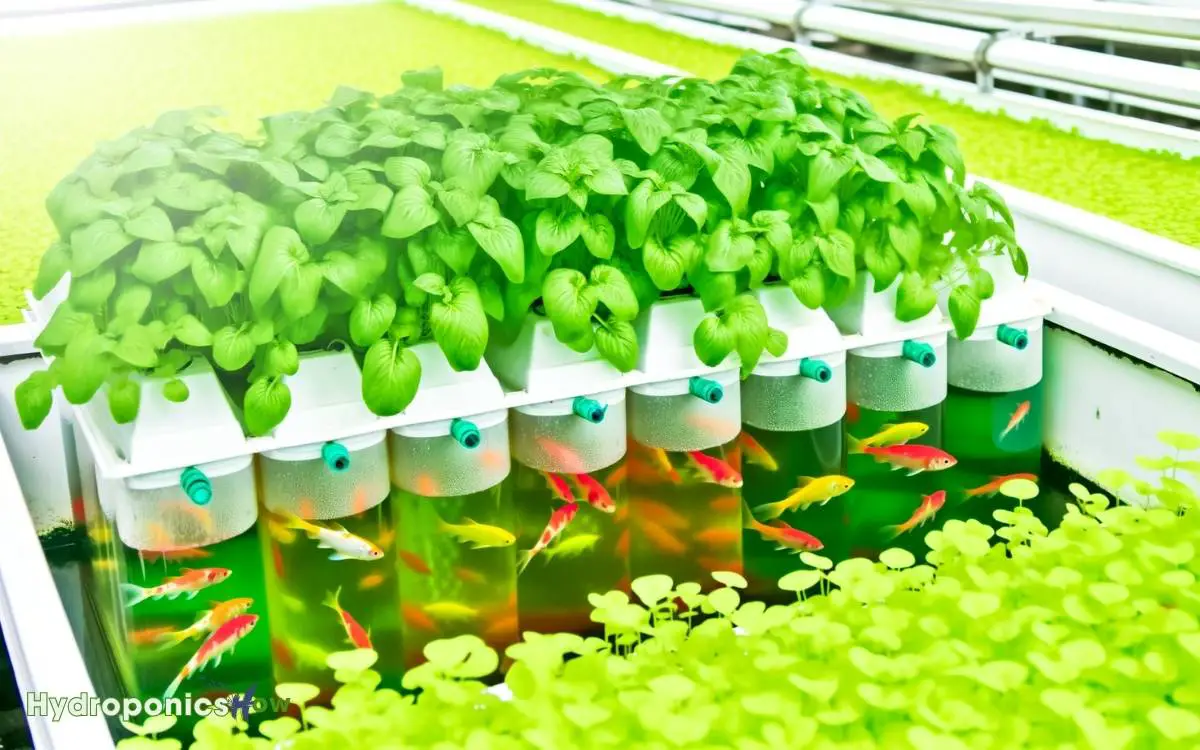
Key Takeaways
What Is Hydroponics?
Hydroponics is a method of growing plants without soil by using mineral nutrient solutions in an aqueous solvent. This technique allows for precise control over nutrient delivery, which can improve plant growth efficiency and yield. By eliminating soil, this method reduces the risk of soil-borne diseases and pests, leading to healthier crops. Additionally, hydroponic systems consume less water compared to traditional farming, making them a more sustainable option. Proper management of hydroponic plant requirements, such as nutrient composition, pH levels, and oxygen availability, is essential to ensure optimal growth and productivity.
By eliminating soil, hydroponics reduces the risk of soil-borne diseases and pests, consequently minimizing the need for chemical pesticides.
The method utilizes various systems, such as nutrient film technique (NFT), deep water culture (DWC), and drip systems, to deliver nutrients directly to the plant roots.
Sustainable practices, such as water recirculation and reduced land use, make hydroponics an environmentally-friendly option for agriculture.
Its scalability and resource efficiency are particularly advantageous in urban settings and regions with arid climates, contributing to more sustainable food production systems.
How Aquaponics Works
Central to the functionality of aquaponics is the symbiotic relationship between fish and plants, where fish excrete waste that is converted by beneficial bacteria into nutrients readily absorbed by plant roots.
This closed-loop system guarantees efficient nutrient recycling and water conservation.
| Component | Function |
|---|---|
| Fish | Produce waste containing ammonia |
| Beneficial Bacteria | Convert ammonia to nitrites, then to nitrates (plant nutrients) |
| Plants | Absorb nitrates, purifying the water |
| Water Pump | Circulates water between fish tank and grow bed |
| Grow Bed | Medium for plant roots and bacteria colonization |
The water pump circulates nutrient-rich water to the grow bed, where plants utilize nitrates, effectively filtering and returning clean water to the fish tank. This integrated system highlights sustainable agricultural practices.
Role of Fish in Aquaponics
The fish in an aquaponics system are not only crucial for providing the ammonia necessary for nutrient cycling but also play a critical role in maintaining the biological balance of the ecosystem.
As fish excrete waste, the ammonia is converted by nitrifying bacteria into nitrites and subsequently into nitrates, which are essential nutrients for plant growth.
This bioconversion process guarantees a sustainable nutrient supply while detoxifying the water for fish health.
Moreover, fish contribute to the microbial diversity within the system, enhancing resilience against pathogens.
The integration of fish creates a closed-loop system that reduces the need for chemical fertilizers, promoting an environmentally-friendly method of cultivation that aligns with sustainable agricultural practices.
Types of Fish Used
Several species of fish are commonly utilized in aquaponics systems. Each species is selected for its adaptability to controlled environments, growth rate, and compatibility with plant nutrient requirements.
Tilapia is a popular choice due to its high tolerance for varying water conditions and rapid growth. These fish are known for their hardiness.
Trout is another frequently used species in aquaponics. They are cold-tolerant and thrive in cooler climates.
Catfish are favored for their robust nature and efficient feed conversion.
Ornamental fish like koi and goldfish are used in smaller, decorative aquaponics systems. They are valued for their resilience and aesthetic appeal.
These fish species not only support plant growth by producing essential nutrients through their waste but also uphold the sustainability of the aquaponics ecosystem.
Nutrient Cycle Explained
The nutrient cycle in hydroponic systems integrated with fish, known as aquaponics, begins with fish waste, which is rich in essential nutrients such as nitrogen and phosphorus. These nutrients are then absorbed by the plants, facilitating their growth and development.
Concurrently, the water undergoes natural filtration as plants uptake these nutrients, resulting in a sustainable and symbiotic ecosystem.
Fish Waste Nutrients
In hydroponic systems, fish waste serves as a rich source of essential nutrients, effectively driving the nutrient cycle that sustains plant growth.
The waste, primarily composed of ammonia, undergoes nitrification through beneficial bacteria, converting it into nitrites and then nitrates, which plants readily absorb.
This nutrient transformation is critical for maintaining a balanced, sustainable ecosystem within the system.
| Fish Waste Component | Transformation Process | Resulting Nutrient |
|---|---|---|
| Ammonia (NH3) | Nitrification | Nitrites (NO2-) |
| Nitrites (NO2-) | Nitrification | Nitrates (NO3-) |
| Solid Waste | Mineralization | Micronutrients |
| Organic Compounds | Decomposition | Essential Elements |
| Fish Feed Residue | Breakdown | Additional Nutrients |
Understanding this cycle allows for optimizing plant nutrition and achieving sustainable hydroponic cultivation.
Plant Absorption Process
How do plants effectively absorb and utilize these transformed nutrients within a hydroponic system?
In aquaponics, plants rely on a well-orchestrated nutrient cycle. Microorganisms, particularly nitrifying bacteria, convert fish waste into nitrate a more plant-available form of nitrogen.
Roots then absorb these essential nutrients directly from the water. This process is facilitated by the plant’s root system, which actively uptakes water and dissolved minerals through osmosis and active transport mechanisms.
Additionally, the symbiotic relationships with beneficial bacteria enhance nutrient availability and uptake efficiency.
This holistic nutrient absorption process not only promotes optimal plant growth and health but also aligns with sustainable agricultural practices by minimizing waste and maximizing resource utilization, thereby creating a balanced ecosystem.
Water Filtration Role
Understanding the role of water filtration within the nutrient cycle is key to optimizing plant growth in aquaponic systems. Water filtration plays a critical role in the removal of solid fish waste, which, if left unchecked, can lead to harmful ammonia buildup.
The process involves mechanical filters to trap particulate matter and biofilters where beneficial bacteria convert ammonia into nitrites and subsequently into nitrates. These nitrates are essential nutrients for plant growth.
Effective filtration maintains water quality, fostering a balanced ecosystem where both fish and plants thrive.
Sustainable aquaponic practices prioritize consistent monitoring and maintenance of filtration systems to prevent nutrient imbalances and promote the health of the entire system, resulting in higher yields and more efficient resource use.
Benefits of Aquaponics
Aquaponics integrates fish farming and hydroponics, creating a symbiotic environment that promotes sustainable nutrient cycling.
This method not only enhances plant growth through the continuous supply of natural nutrients but also notably reduces water usage compared to conventional agriculture.
The combined system offers a viable solution for sustainable food production, balancing ecological and economic benefits.
Sustainable Nutrient Cycling
Integrating hydroponics with aquaculture, aquaponics offers a sustainable nutrient cycling system that minimizes waste and enhances resource efficiency.
In this closed-loop system, fish waste serves as a natural fertilizer for plants, converting ammonia into nitrates through bacterial nitrification.
This symbiotic relationship eliminates the need for synthetic fertilizers, reducing chemical runoff into ecosystems.
Additionally, water usage is optimized as the same water circulates between fish tanks and plant beds, greatly lowering consumption compared to traditional agriculture.
The system’s ability to recycle nutrients continuously guarantees a balanced environment, promoting healthier plant growth and fish development.
This method aligns with sustainable practices, providing a viable solution for food production in resource-limited settings while maintaining ecological integrity.
Enhanced Plant Growth
The essential relationship inherent in aquaponics not only optimizes nutrient recycling but also greatly enhances plant growth by providing a constant supply of natural, nutrient-rich water.
This nutrient solution, derived from fish waste, contains vital macro and micronutrients such as nitrogen, phosphorus, potassium, and trace elements.
These nutrients are continuously available to the plants, fostering accelerated growth rates and improved yields compared to traditional soil-based cultivation.
Root systems are consistently bathed in oxygenated, nutrient-dense water, which minimizes plant stress and maximizes nutrient uptake.
Additionally, the microbial communities in the system play a pivotal role in nutrient conversion and pathogen suppression, contributing to healthier and more robust plant development.
This holistic approach underscores aquaponics’ potential for sustainable and efficient agricultural practices.
Reduced Water Usage
One of the primary benefits of aquaponics is its significant reduction in water usage compared to traditional agricultural methods. In conventional soil-based farming, a substantial portion of water is lost through evaporation and runoff.
However, aquaponics utilizes a closed-loop system where water is recirculated between the fish tanks and plant beds. This method guarantees that water remains within the system, minimizing loss and maximizing efficiency.
Scientific studies have shown that aquaponics can reduce water consumption by up to 90% compared to traditional farming.
Additionally, the continuous circulation of water provides essential nutrients to plants, eliminating the need for chemical fertilizers. This sustainable approach not only conserves water but also promotes a more environmentally-friendly agricultural practice.
Challenges in Aquaponics
Achieving a balanced ecosystem in aquaponics systems presents significant challenges, particularly in maintaining ideal water quality and nutrient levels for both fish and plants.
Precise monitoring of pH levels, ammonia, nitrates, and dissolved oxygen is critical. Excessive ammonia, for instance, can be toxic to fish, while insufficient nitrates may limit plant growth.
Temperature regulation is equally crucial, as both fish and plants have specific thermal requirements.
Additionally, the integration of mechanical and biological filtration systems is essential for removing solid waste and converting harmful substances into usable nutrients. Balancing these elements demands a high degree of expertise and constant vigilance.
Moreover, disease management poses a challenge, necessitating sustainable practices to minimize the use of chemicals and promote ecosystem health.
Plant Varieties for Aquaponics
In aquaponics systems, selecting plant varieties that thrive in nutrient-rich, aquatic environments is essential for optimizing both plant health and overall system efficiency.
Leafy greens such as lettuce, spinach, and kale are particularly well-suited due to their rapid growth rates and minimal nutrient requirements.
Additionally, herbs like basil, mint, and parsley benefit from the nutrient-dense water, exhibiting robust growth. Fruiting plants, including tomatoes, cucumbers, and peppers, can also be cultivated, though they may require more precise nutrient management.
Root vegetables such as carrots and radishes are less commonly grown due to their specific substrate needs.
Implementing crop rotation and companion planting can further enhance system sustainability, ensuring a balanced nutrient uptake and reducing pest pressure.
Setting Up an Aquaponic System
Establishing an effective aquaponic system requires a meticulous approach to system design, water quality management, and the integration of fish and plant species to create a balanced, self-sustaining ecosystem.
Key considerations include selecting an appropriate tank size and ensuring adequate aeration and filtration systems.
Water quality parameters such as pH, temperature, and nutrient levels must be continually monitored and adjusted to support both aquatic life and plant growth.
Choosing compatible fish and plant species is critical; for instance, tilapia and leafy greens are commonly paired due to their mutual environmental preferences.
Sustainable practices, including the use of organic materials and energy-efficient equipment, further enhance the long-term viability and ecological footprint of the aquaponic setup.
Maintenance Tips
Maintaining an aquaponic system involves regular monitoring and adjustments to guarantee ideal conditions for both fish and plants. To achieve peak performance, routine checks and maintenance are vital.
Key tasks include:
- Water Quality Management: Regularly test pH, ammonia, nitrite, and nitrate levels to maintain a balanced aquatic environment.
- Temperature Control: Keep water temperature within a suitable range for the specific fish and plant species.
- Feeding Practices: Provide appropriate quantities of high-quality feed to avoid overfeeding and water contamination.
- System Cleanliness: Periodically clean tanks, pipes, and grow beds to prevent the buildup of waste and algae.
- Component Inspection: Regularly inspect pumps, filters, and aeration systems for functionality and efficiency.
Adhering to these maintenance tips ensures a sustainable and productive aquaponic system.
Cost Considerations
Evaluating the cost considerations of integrating hydroponic systems with aquaponics requires an analysis of initial setup expenses, ongoing maintenance costs, and potential savings.
Initial investments include equipment for both hydroponics and aquaculture systems, while recurring costs encompass water quality management, fish feed, and plant nutrients.
However, the symbiotic relationship between fish and plants can lead to significant resource efficiencies and long-term financial benefits through reduced fertilizer use and optimized water consumption.
Initial Setup Expenses
A thorough analysis of initial setup expenses for a hydroponic system integrated with aquaculture reveals significant investments in equipment, infrastructure, and ongoing operational costs.
These initial expenses can be substantial but are vital for establishing a sustainable and efficient system.
Key components include:
- Hydroponic growing beds and tanks: Essential for plant and fish cultivation.
- Water circulation systems: Pumps, filters, and pipes to guarantee proper nutrient and oxygen distribution.
- Monitoring and control systems: Sensors and automation for pH, temperature, and nutrient levels.
- Fish stock and plant seedlings: Initial biological inputs for the system.
- Lighting and heating systems: Critical for optimizing growth conditions in controlled environments.
Each of these elements plays an integral role in the system’s overall functionality and sustainability.
Ongoing Maintenance Costs
While initial setup expenses represent a significant investment, ongoing maintenance costs also play a critical role in the long-term viability of a hydroponic system integrated with aquaculture.
Regular expenses include the continuous monitoring and adjustment of water quality parameters, such as pH, dissolved oxygen, and nutrient levels, to guarantee ideal conditions for both plants and fish. Energy costs for lighting, pumps, and aeration systems are also pivotal.
Additionally, periodic replacement of components like water filters, and potential health management for fish, including disease prevention and treatment, contribute to ongoing costs.
Sustainable practices, such as using energy-efficient equipment and recycling water, can mitigate some expenses, yet detailed planning and budgeting are essential for maintaining system efficiency and productivity over time.
Potential Savings Benefits
Integrating hydroponics with aquaculture can offer significant cost-saving benefits through resource efficiency and reduced waste.
This synergistic approach, known as aquaponics, leverages the natural symbiosis between fish and plants to optimize resource use.
The fish produce waste that provides essential nutrients to the plants, while the plants help purify the water, creating a closed-loop system.
Key cost-saving benefits include:
- Reduced water usage: Aquaponics systems use up to 90% less water than traditional farming methods.
- Lower fertilizer costs: Fish waste naturally supplies the necessary nutrients for plant growth.
- Decreased labor expenses: Automated systems streamline maintenance and monitoring.
- Enhanced space utilization: Vertical farming techniques maximize yield per square foot.
- Sustainable practices: Minimizing chemical usage reduces environmental impact and associated costs.
Future of Aquaponics
Advancements in aquaponics technology are poised to revolutionize sustainable agriculture by integrating closed-loop systems that maximize resource efficiency.
Emerging innovations focus on optimizing nutrient cycling, enhancing water quality management, and automating system controls to reduce labor costs.
Cutting-edge bioreactors and biofilters improve the breakdown of organic matter, facilitating nutrient-rich water for plant growth.
Additionally, precision sensors and Internet of Things (IoT) devices enable real-time monitoring and data-driven decision-making to guarantee ideal conditions.
Researchers are exploring genetic improvements in both fish and plant species to enhance productivity and resilience.
As these technologies evolve, aquaponics is expected to contribute significantly to food security and environmental sustainability, offering scalable solutions for urban and rural farming applications.
Conclusion
In summation, aquaponics seamlessly marries hydroponics with aquaculture, creating a symbiotic environment where plants and fish thrive in mutualistic harmony.
This innovative approach leverages natural biological cycles, reducing the need for synthetic inputs and promoting sustainable agricultural practices.
By selecting appropriate fish species and adhering to meticulous maintenance protocols, aquaponics can offer a cost-effective and environmentally friendly alternative to traditional farming methods.
The burgeoning interest in this field heralds a promising future for sustainable food production.

